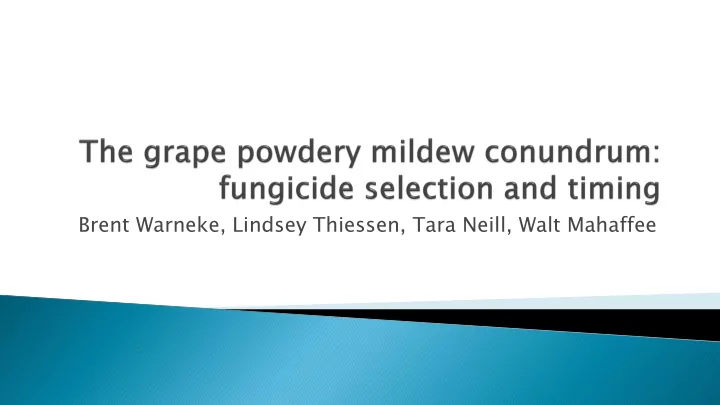

Brent Warneke, Lindsey Thiessen, Tara Neill, Walt Mahaffee
Grape powdery mildew ◦ Life cycle ◦ Management Fungicide application timing Field mobility assessment Pinot Noir in the Willamette Valley, OR
Primary y Infecti ction on Asexual xual reprodu duct ctio ion Overwi rwinte nterin ing Sexual xual reprodu duct ctio ion
Little natural resistance present in V. vinifera Fungicides have been used successfully for 150 years Typically applied on a calendar schedule Sulfur dusting in Fresno, CA 1972 Bordeaux mixture c. 1903 Gene Daniels, EPA Fr.wikipedia
Flowering and early cluster development Primary ry Infect ction Secon econda dary ry Infect ction Timing applications to critical fruit development stages increases disease control efficiency
Motivations ◦ We often find disease on inflorescences or clusters ◦ Various products claim mobility to unprotected tissues 57 65 68 61 63 Graphics of the BBCH phenological scale 71 75 77 73 (Lorenz et al., 1995)
Figur ure e 4. Air turbulence directing pollen into the cone between scale-bracts (A) and over the scale-bracts (B), and eddy formation redirecting airflow onto the leeward side of the cone. Image Credit: K. Niklas (27)
Determine the most effective fungicide application timing with relation to grape inflorescence phenological stage
3x5 factorial ◦ 3 flowering stages ◦ 5 fungicides Randomized complete block design Weekly leaf incidence assessments Berry incidence assessed prior to veraison
FRAC Rate per Fungicide Activity Group acre xylem mobility and Quinoxyfen 13 4 fl oz volatilization xylem mobile Tebuconazole 3 4 oz Fluopyram 7 locally systemic 4 fl oz Trifloxystrobin 11 locally systemic 2 oz Sulfur M2 non-systemic, volatilization 3 lb
57 61 63 65 68 Inflorescence 50% Bloom Berry set elongation BBCH 65 BBCH 69 BBCH 55
Fungicide de Experimental Sulfur every applicati tion ons Treatments Sulfur every 14 days 14 days April September July August May June Data collecti ction on Disease assessments Cluster Collection
201 016 201 015 Fungicide de Stage Inflorescence elongation 50% Bloom Berry set 57 61 63 65 68 71 75 77 73
2016 16 2015 15 Stage Inflorescence elongation 50% Bloom Berry set
• Bars are 95% confidence intervals • Points are the mean probability of berry infection
The bold horizontal line is at 1, indicating no difference between the two timings compared In general later timings were more effective
40 clusters per treatment were marked with ribbon During application clusters were covered with plastic bags These clusters were expected to have as much disease as the water control since they received no direct spray Plastic bags covering clusters during an application
Difference in the probability of infection between the water control and the Fungicide bagged cluster Most of the treatments showed some protective activity ◦ Vapor movement
Fluopyram, quinoxyfen, and trifloxystrobin were most efficacious when applied later in bloom All five fungicides tested appeared to be mobile in the field ◦ Vapor movement Applegate Valley Chardonnay, Southern Oregon
Using the concepts of fungicide mobility and application timing to efficiently control powdery mildew on grape berries in a commercial setting
Foliar Pathology lab • Funding Source ◦ Walt Mahaffee • Oregon Wine Board ◦ Tara Neill ◦ Lindsey Thiessen • Collaborators ◦ Carly Allen • Jason Tosch, Stoller ◦ Bailey Williams Family Estate ◦ Katelynn Thrall • Ashley Lindsay, ◦ Chris Gorman Willamette Valley ◦ Andy Albrect Vineyard OSU Botany farm ◦ Steve Clusky
Lorenz, D. h., Eichhorn, K. w., Bleiholder, H., Klose, R., Meier, U., & Weber, E. (1995). Growth Stages of the Grapevine: Phenological growth stages of the grapevine (Vitis vinifera L. ssp. vinifera) — Codes and descriptions according to the extended BBCH scale†. Australian Journal of Grape and Wine Research , 1 (2), 100 – 103. https://doi.org/10.1111/j.1755- 0238.1995.tb00085.x
Recommend
More recommend